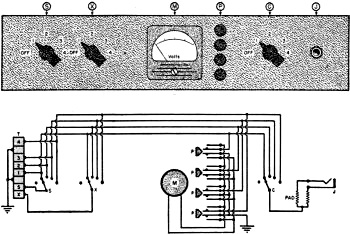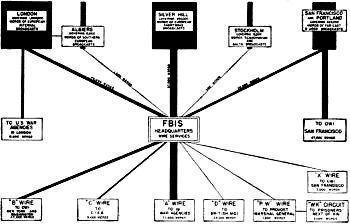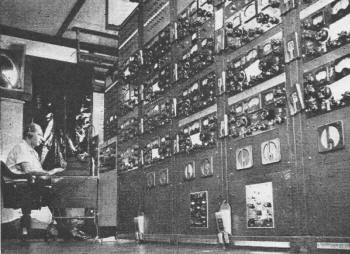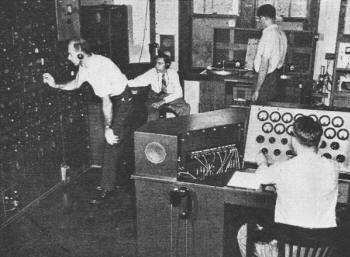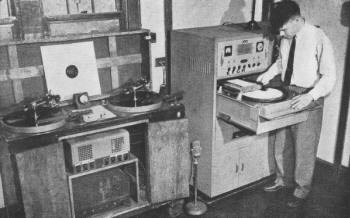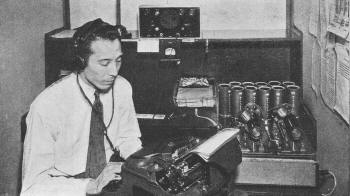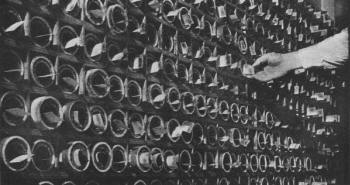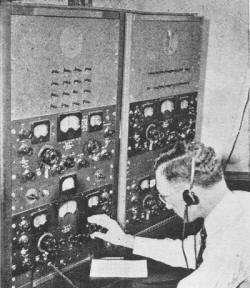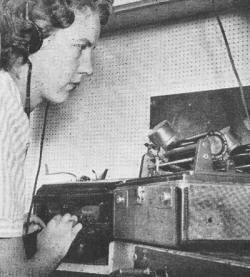Foreign Broadcast Intelligence Service
|
||
You will not find the name Central Intelligence Agency (CIA) mentioned anywhere in this WWII era (1945 Radio News magazine) story reporting on the activities of the Foreign Broadcast Intelligence Service (FBIS), since the CIA was not formally established until 1947. FBIS became a branch of branch the CIA, however. Per the CIA website "For nearly 70 years, the Foreign Broadcast Information Service (FBIS) monitored the world's airwaves and other news outlets, transcribing and translating selected contents into English and in the process creating a multi-million page historical archive of the global news media." Equally surprising is that the British Broadcasting Service (BBC) has a similar activity known as the Summary of World Broadcasts (SWB). Together, their operators attempted to monitor every radio transmission made worldwide in order to provide intelligence for the war effort. As with so many forms of technology during the war years, intelligence gathering capability grew rapidly and significantly. Listening to "chatter" amongst military personnel, underground resistance members, government offices, citizens citing sighted activity, media field staff reporting to their offices, and other broadcast sources was a major source of planning data. A big part of the job was attempting to discern whether intercepted communications were legitimate or deliberate misinformation. Foreign Broadcast Intelligence Service FBIS receiving station at Silver Hill, Md. Highly directional antennas connect at this building to one of the most elaborate receiving installations in the world. By Oliver Read, W9ETI Managing Editor, Radio News Radio, as an instrument of propaganda, has proved its importance beyond any doubt. It reveals many psychological slips. A little-known governmental agency, but one of extreme importance in wartime, is the Foreign Broadcast Intelligence Service (FBIS) of the Federal Communications Commission. The FBIS came into being nine months before Pearl Harbor when this official monitoring service was set up to keep our Government informed of what the enemy radio was saying to its own people, to neutrals, and to its enemies. Due to lack of normal peacetime sources of information, a continuous round-the-clock monitoring of the short waves provided intelligence agencies of this and other friendly governments with valuable clues as to enemy strategy and how best it might be combated on military, economic, and propaganda fronts. Four listening posts manned by skilled engineers, linguists, students of public affairs, and editors sift through 2,500,000 words a day of foreign broadcast material and send it minute-by-minute over teletypes to nineteen government war agencies. It is interesting to go back and review the normal chain of events that led to the development of the FBIS. Radio broadcasting developed originally in the "medium-wave" part of the radio spectrum - the part where most ordinary domestic broadcasting is now carried on. Dr. Frank Conrad of Westinghouse and Signor Marconi in Italy were experimenting with broadcasting on much shorter wavelengths early in 1923, using radio waves of 100 meters or less instead of the 360-meter waves used by standard broadcasting at that time. It was noted that for long-distance broadcasting these shorter waves possessed many advantages. Soon experimental short-wave broadcasting stations in the U. S. and in England were exchanging programs. Thus, international broadcasting was inaugurated about 1923. Audio level and output control panel, used at the FBIS receiving station at Silver Hill. Md. (P) Push buttons to check audio level. (C) Selective switch for phone output. (M) Voltmeter (0-150) with 2250 ohms substituted for multiplier. (S) Selective switch for Memovox recorders. (J) Phone jack. (T) Terminal for rack of four receivers. Organization chart of the Foreign Broadcast Intelligence Service (FBIS). Monitoring officer "logs" transmissions from all parts of the world and notes the exact time which they are heard, together with any other information needed for future reference. Radio transmissions are picked up by 29 SX-28 receivers and piped through the console (foreground) to the wax cylinder recorders located seven miles from this receiving station. David Cooper, FBIS Supervisor, records a broadcast on a Memovox machine. Over an hour's intelligence may be recorded on each side of the flexible discs. Continuous recording is possible by using duplicate machines. This monitoring officer, at Portland, Oregon, caught the sensational news that Tokyo had been raided by Gen. Doolittle's flyers. Japanese broadcasts are four times more difficult to interpret than any others. Wax cylinders containing the original intelligence that has been received from the elaborate receiver installation located at Silver Hill, Maryland, are kept for a period of forty-eight hours. and then are reshaven for further use. These original international broadcasts were relayed. There existed in each country but a handful of radio receivers capable of tuning in shortwave programs. The only way to build up audiences for these broadcasts was to pick them up and then rebroadcast them in the standard radio band used by ordinary listeners. The cooperation of radio stations in both countries was required for successful international broadcasting. No one doubted in the early twenties that this international broadcasting would be a prime force of international peace and good will among nations. They anticipated no friction. Shortly thereafter, however, radio amateurs and others began constructing radio receivers which were able to pick up foreign broadcasts directly by short-wave instead of being limited to the standard band rebroadcasts of these international programs. Soon, enterprising manufacturers were marketing radio receivers that included short-wave bands and anyone could listen to foreign broadcasts on short-wave. The result was that the international broadcast stations could build up listening audiences from other countries even for those programs which the other countries chose not to rebroadcast. About this time medium-wave broadcasts were being used across national borders for political propaganda. The Russians took the lead in this field. Adolph Hitler in 1933 rose to power with his doctrine that "words are deeds" and quickly perceived the disrupted possibility of sowing seeds of distrust and dissension by international radio. Short-wave transmitters became a new kind of Nazi weapon. Transmitters were pouring forth words in scores of languages by 1938. Great Britain used the short waves extensively as a means of welding the far flung dominions to the Mother country. The League of Nations broadcast news of its activities through a powerful Swiss station. The Nazis were stirring up conflict within neighboring countries. The Germans developed special directional antenna systems for their transmitters and beamed their propaganda to every corner of the world. The British, for example, would be told that the United States would soon dominate the world, while the Americans were simultaneously being warned through another transmitter that the British were the chief danger. When war came in 1939, this radio warfare became intensified. Lord Haw-Haw, the Nazi radio star, built up a tremendous listening audience in England and was featured on front pages of American newspapers. In this way, direct German propaganda procured the fullest access into both Britain and the United States. Simultaneously, the Nazi barrage of anti-American broadcasts to Latin America was intensified. The FBIS was set up at the suggestion of the State Department with the approval of the Board of War Communications to operate as a central agency serving all Government agencies requiring foreign broadcast material. There are nine simultaneous or successive steps in FBIS operations. These are (1) Scheduling; (2) Interception; (3) and (4) Monitoring and recording (that go on simultaneously); (5) Translating; (6) Wire services, including editing and teletyping; (7) reports (including editing and mimeographing); (8) analysis (including periodic and special reports) and (9) individual services of various kinds. Special services are provided by the FBIS to Government officials requesting them. For example; at the time of the Hitler speech following the Italian surrender, the White House had a special telephone installation with Hitler's voice on one end and Churchill, General Marshall and others on the receiving end. Principal speeches by German and Japanese leaders, by standing order, are recorded as received on permanent high fidelity discs and are furnished the OWI and the equivalent British Overseas Broadcast agency for use in their Library of Direct Quotations. We visited the FBIS receiving station at Silver Hill, Md., to get first-hand information on the important functions of this nonmilitary unit. There are four such stations operating for the express purpose of checking all foreign short-wave broadcast transmissions, recording their content and interpreting them into English. The receiving stations are chosen for excellence of reception. They include a maze of communications receivers (Hallicrafters SX-28's), Memovox and Presto recorders, and various and sundry units assembled and developed by FBIS personnel. The receivers are mounted in bays. They are easily accessible from the rear for quick servicing. All of the sets are in continuous operation. There are twenty-nine of these in operation at Silver Hill alone. In charge of each receiving station is a Monitoring Officer. Under him are a number of monitoring officers and radio operators working in shifts, whose job it is to maintain an accurate worldwide program "log" and to pretune receivers to prescheduled programs over a twenty-four hour period. Connecting to these receivers is a highly complex antenna system including five Rhombic antennas, each covering a maximum angle of twenty degrees. The operators select the antenna which provides the strongest signals to be heard. The outputs of the receivers go through a control console provided with complete "patching" facilities. There are special telephone circuits which go to the central office located many miles distant and which terminate to wax cylinder recorders. The audio level is maintained by the console operator at a predetermined level, one which will afford correct modulation for the wax-cylinder recorders. Other equipment, as mentioned previously, includes Memovox recorders employing paper-based discs capable of holding over an hour's recording per side. These are used when a complete transcription is required for counter-propaganda purposes. In addition, two Presto tables are in readiness to record any type of intelligence requiring high fidelity. The FBIS interpreters are not located at the receiving stations. They work from the downtown headquarters of the FBIS in Washington (seven miles away). The experts of the FBIS are equipped to monitor thirty-four different languages plus thirty other dialects. Most of the interception carried out by the personnel involves voice broadcasts. A small part, particularly enemy news, is transmitted by International Morse code. The Germans use it frequently. The Jap Domei Morse in the Japanese language presents some peculiar difficulties however. It is directed from Tokyo to its satellite newspapers in the Asiatic area. The Jap announcement of the resignation of the two Japanese Chiefs of Staff, for example, was first received in the United States via these Jap press broadcasts. The Japanese language itself is written in ideographs which cannot be transferred directly into dots and dashes. They must first be changed into a Roman alphabet reading of the Jap language on a purely phonetic basis. This Romaji is then transmitted by International Morse code. At Portland, Oregon, where Jap broadcasts are monitored, engineers receive and type it out as so many meaningless letters. It is teletyped in this form and is translated to English at the Washington headquarters. Such translations take about four times as long as for any other language. These experts, specializing in various languages, listen to the programs as they come over the telephone circuits. They wear a pair of headphones and type the intelligence as they listen. They do not make a complete transcription, however, unless it is of extreme importance. A second cylinder may be cut in instantaneously so that an uninterrupted recording may be had. These are kept in special racks for a period of forty-eight hours in case an entire program is requested by one of the various agencies using the service. Other important functions of the FBIS include editorial and teletype rooms. A special service has been rendered on occasions to the Department of Justice. This is in connection with trials involved in sedition, violation of alien registration laws, and the treason clause of the Constitution of the United States. One of these was in August, 1942, of William Dudley Pelley and two other defendants on charges of having violated the federal sedition Act. Dr. Pelley, leader of the American Silver shirt organization, was publisher at the time of the trial of a periodical called "The Galilean." This periodical contained material reflect-ng and corresponding to the main lines of Axis propaganda and contained no material which contradicted these main lines of Axis propaganda. Frank X. Green, monitoring officer-in-charge, cruises the ether in search of new stations or program changes. Miss Ann Wilkinson, French language monitor and daughter of Vice Admiral T. S. Wilkinson, shown listening at her post. Two government witnesses, one of them Ensign Harold N. Graves, Jr., then Assistant to the Director of FBIS, who testified to the main lines of Axis propaganda, identified fourteen themes constantly "harped on" by the radios of Germany and Italy. The second witness, Dr. Harold Lasswell of the Library of Congress, testified that an analysis of "The Galilean" showed it to reflect Axis propaganda to a considerable degree. It was shown at the trial that members of "The Galilean" organization actually had taken notes of foreign short-wave broadcasts and that on at least one occasion, notes from an Italian radio broadcast had appeared with some modification in following issues of "The Galilean." Pelley was convicted and sentenced to five years in the penitentiary. The case was appealed but the verdict was upheld by a higher court. Historical news, too, has come from the facilities of the FBIS. For example, the scoop story on Doolittle's raid on Tokyo back in April, 1942, was made possible by the alertness of one of the monitors at the Portland, Oregon, receiving station. Picking up the Japanese word "Kushu" and thinking simultaneously in ideographs (picture characters which give the meaning of Jap words) this monitor knew that here was the news all America awaited. Upon completion of the item it now was known that our fliers had successfully raided and bombed Kobe and Nagoya. This information was later confirmed by the Doolittle fliers themselves. It is interesting to note that most of the operating personnel at the receiving stations are, or were, radio amateurs. Their skill and technical know-how gave them a valuable background for this type of work. In charge of the station at Silver Hill is Frank X. Green, former engineer of KFXJ, KFEL, KOA, KMA, and KIVL. While there we met an interesting chap by the name of James G. Wedewer, Assistant Monitoring Officer, who is an official of several short-wave listening clubs and an authority on short-wave broadcast stations of the world. He told us the location of all the call letters we mentioned. A group of four Hallicrafters SX-28 receivers is used for scanning the ether for new stations, changes in schedules and other information in order to keep the "log" accurate. Each receiver is supplied with a small booklet placed in a metal clip adjacent to the set. Complete calibrations are included which show the exact tuning setting for any frequency throughout the spectrum. These must be kept currently accurate, particularly if a sudden change in weather is encountered. A constant check on frequency is had by means of several crystal controlled secondary standards that put out signals at either 100 or 1000 kc. The personnel at Silver Hill rigged up a special changeover switch (seen at the bottom of the receiver bays) so that this signal is accessible for checking the receivers simply by pressing the switch with the toe. We have visited many military and nonmilitary installations all over the country throughout the present war. Never have we seen so many receivers going at one time in one place. If ever there was an ideal all-wave receiver this was it. In fact, it might well be called "Uncle Sam's radio set" - at least one of them.
Posted February 18, 2022 |
||


